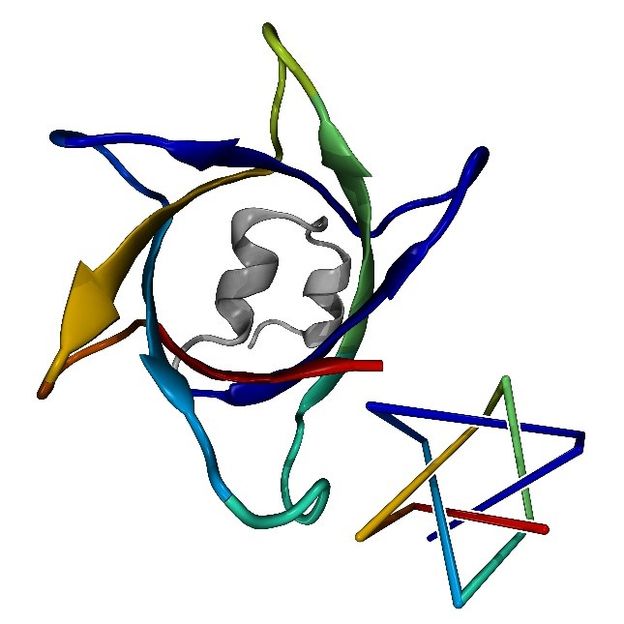Most complex protein knots
Theoretical physicists put Google's artificial intelligence AlphaFold to the test and find the most complex protein knots so far
The question of how the chemical composition of a protein, the amino acid sequence, determines its 3D structure has been one of the biggest challenges in biophysics for more than half a century. This knowledge about the so-called "folding" of proteins is in great demand, as it contributes significantly to the understanding of various diseases and their treatment, among other things. For these reasons, Google's DeepMind research team has developed AlphaFold, an artificial intelligence that predicts 3D structures.

The most complex protein knot with seven crossings (left) predicted by AlphaFold and a simplified representation (right)
© Maarten Brems
A team consisting of researchers from Johannes Gutenberg University Mainz (JGU) and the University of California, Los Angeles, has now taken a closer look at these structures and examined them with respect to knots. We know knots primarily from shoelaces and cables, but they also occur on the nanoscale in our cells. Knotted proteins can not only be used to assess the quality of structure predictions but also raise important questions about folding mechanisms and the evolution of proteins.
The most complex knots as a test for AlphaFold
"We investigated numerically all – that is some 100,000 – predictions of AlphaFold for new protein knots," said Maarten A. Brems, a PhD student in the group of Dr. Peter Virnau at Mainz University. The goal was to identify rare, high-quality structures containing complex and previously unknown protein knots to provide a basis for experimental verification of AlphaFold's predictions. The study not only discovered the most complex knotted protein to date but also the first composite knots in proteins. The latter can be thought of as two separate knots on the same string. "These new discoveries also provide insight into the evolutionary mechanisms behind such rare proteins", added Robert Runkel, a theoretical physicist also involved in the project. The results of this study were recently published in Protein Science.
Dr. Peter Virnau is pleased with the results: "We have already established a collaboration with our colleague Todd Yeates from UCLA to confirm these structures experimentally. This line of research will shape the biophysics community's view of artificial intelligence – and we are fortunate to have an expert like Dr. Yeates involved."
Original publication
Original publication
John Jumper et al.; Highly accurate protein structure prediction with AlphaFold; Nature, 15. Juli 2021
Maarten Brems, Robert Runkel, Todd Yeates, Peter Virnau; AlphaFold predicts the most complex protein knot and composite protein knots; Protein Science, 13. Juli 2022
Topics
Organizations
Other news from the department science
These products might interest you

Kjel- / Dist Line by Büchi
Kjel- and Dist Line - steam distillation and Kjeldahl applications
Maximum accuracy and performance for your steam distillation and Kjeldahl applications

AZURA Purifier + LH 2.1 by KNAUER
Preparative Liquid Chromatography - New platform for more throughput
Save time and improve reproducibility during purification

Get the analytics and lab tech industry in your inbox
By submitting this form you agree that LUMITOS AG will send you the newsletter(s) selected above by email. Your data will not be passed on to third parties. Your data will be stored and processed in accordance with our data protection regulations. LUMITOS may contact you by email for the purpose of advertising or market and opinion surveys. You can revoke your consent at any time without giving reasons to LUMITOS AG, Ernst-Augustin-Str. 2, 12489 Berlin, Germany or by e-mail at revoke@lumitos.com with effect for the future. In addition, each email contains a link to unsubscribe from the corresponding newsletter.























































